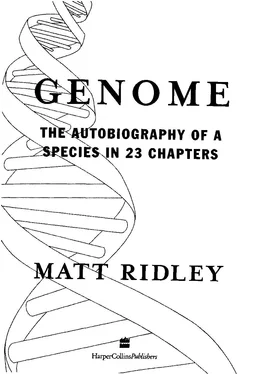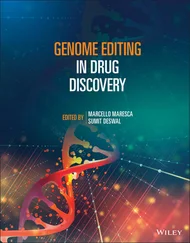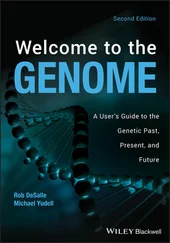Genome - Matt Ridley
Здесь есть возможность читать онлайн «Genome - Matt Ridley» — ознакомительный отрывок электронной книги совершенно бесплатно, а после прочтения отрывка купить полную версию. В некоторых случаях можно слушать аудио, скачать через торрент в формате fb2 и присутствует краткое содержание. Жанр: Старинная литература, на английском языке. Описание произведения, (предисловие) а так же отзывы посетителей доступны на портале библиотеки ЛибКат.
- Название:Matt Ridley
- Автор:
- Жанр:
- Год:неизвестен
- ISBN:нет данных
- Рейтинг книги:5 / 5. Голосов: 1
-
Избранное:Добавить в избранное
- Отзывы:
-
Ваша оценка:
- 100
- 1
- 2
- 3
- 4
- 5
Matt Ridley: краткое содержание, описание и аннотация
Предлагаем к чтению аннотацию, описание, краткое содержание или предисловие (зависит от того, что написал сам автор книги «Matt Ridley»). Если вы не нашли необходимую информацию о книге — напишите в комментариях, мы постараемся отыскать её.
Matt Ridley — читать онлайн ознакомительный отрывок
Ниже представлен текст книги, разбитый по страницам. Система сохранения места последней прочитанной страницы, позволяет с удобством читать онлайн бесплатно книгу «Matt Ridley», без необходимости каждый раз заново искать на чём Вы остановились. Поставьте закладку, и сможете в любой момент перейти на страницу, на которой закончили чтение.
Интервал:
Закладка:
In both Prader-Willi and Angelman's syndrome it soon became clear that the same chunk of chromosome 15 was missing. The difference was that in Prader-Willi syndrome, the missing chunk was from the father's chromosome, whereas in Angelman's syndrome, the missing chunk was from the mother's chromosome.
Transmitted through a man, the disease manifests itself as Prader-Willi syndrome; transmitted through a woman it manifests itself as Angelman's syndrome.
These facts fly in the face of everything we have learnt about genes since Gregor Mendel. They seem to belie the digital nature 2 0 8 G E N O M E
of the genome and imply that a gene is not just a gene but carries with it some secret history of its origin. The gene 'remembers' which parent it came from because it is endowed at conception with a paternal or a maternal imprint — as if the gene from one parent were written in italic script. In every cell where the gene is active, the 'imprinted' version of the gene is switched on and the other version switched off. The body therefore expresses only the gene it inherited from the father (in the case of the Prader-Willi gene) or the mother (in the case of the Angelman gene). How this happens is still almost entirely obscure, though there is the beginning of an understanding. Why it happens is the subject of an extraordinary and daring evolutionary theory.
In the late 1980s, two groups of scientists, one in Philadelphia and one in Cambridge, made a surprising discovery. They tried to create a uniparental mouse — a mouse with only one parent. Since strict cloning from a body cell was then impossible in mice (post-Dolly, this is quickly changing), the Philadelphia team swapped the
'pronuclei' of two fertilised eggs. When an egg has been fertilised by a sperm, the sperm nucleus containing the chromosomes enters the egg but does not at first fuse with the egg nucleus: the two nuclei are known as 'pronuclei'. A clever scientist can sneak in with his pipette and suck out the sperm pronucleus, replacing it with the egg pronucleus from another egg — and vice versa. The result is two viable eggs, but one with, genetically speaking, two fathers and no mother and the other with two mothers and no father. The Cambridge team used a slightly different technique to reach the same result. But in both cases such embryos failed to develop properly and soon died in the womb.
In the two-mothers case, the embryo itself was properly organised, but it could not make a placenta with which to sustain itself. In the two-fathers case, the embryo grew a large and healthy placenta and most of the membranes that surround the foetus. But inside, where the embryo should be, there was a disorganised blob of cells with no discernible head.3
These results led to an extraordinary conclusion. Paternal genes, S E X 2 0 9
inherited from the father, are responsible for making the placenta; maternal genes, inherited from the mother, are responsible for making the greater part of the embryo, especially its head and brain.
Why should this be? Five years later, David Haig, then at Oxford, thought he knew the answer. He had begun to reinterpret the mammalian placenta, not as a maternal organ designed to give sustenance to the foetus, but more as a foetal organ designed to parasitise the maternal blood supply and brook no opposition in the process. He noted that the placenta literally bores its way into the mother's vessels, forcing them to dilate, and then proceeds to produce hormones which raise the mother's blood pressure and blood sugar.
The mother responds by raising her insulin levels to combat this invasion. Yet, if for some reason the foetal hormone is missing, the mother does not need to raise her insulin levels and a normal pregnancy ensues. In other words, although mother and foetus have a common purpose, they argue fiercely about the details of how much of the mother's resources the foetus may have — exactly as they later will during weaning.
But the foetus is built parly with maternal genes, so it would not be surprising if these genes found themselves with, as it were, a conflict of interest. The father's genes in the foetus have no such worries. They do not have the mother's interest at heart, except insofar as she provides a home for them. To turn briefly anthropomorphic, the father's genes do not trust the mother's genes to make a sufficiently invasive placenta; so they do the job themselves. Hence the paternal imprinting of placental genes as discovered by the two-fathered embryos.
Haig's hypothesis made some predictions, many of which were soon borne out. In particular, it predicted that imprinting would not occur in animals that lay eggs, because a cell inside an egg has no means of influencing the investment made by the mother in yolk size: it is outside the body before it can manipulate her. Likewise, even marsupials such as kangaroos, with pouches in place of placentas, would not, on Haig's hypothesis, have imprinted genes. So far, it appears, Haig is right. Imprinting is a feature of placental mammals 2 1 0 G E N O M E
and of plants whose seeds gain sustenance from the parent plant.4
Moreover, Haig was soon triumphantly noting that a newly discovered pair of imprinted genes in mice had turned up exactly where he expected them: in the control of embryonic growth. I G F 2 is a miniature protein, made by a single gene, that resembles insulin. It is common in the developing foetus and switched off in the adult.
I G F 2 R is a protein to which I G F 2 attaches itself for a purpose that remains unclear. It is possible that I G F 2 R is there simply to get rid of I G F 2 . Lo and behold, both the IGF2 and the IGF2R
genes are imprinted: the first being expressed only from the paternal chromosome, the second from the maternal one. It looks very much like a little contest between the paternal genes trying to encourage the growth of the embryo and the maternal ones trying to moderate it.5
Haig's theory predicts that imprinted genes will generally be found in such antagonistic pairs. In some cases, even in human beings, this does seem to be the case. The human IGF2 gene on chromosome 11
is paternally imprinted and when, by accident, somebody inherits two paternal copies, they suffer from Beckwith-Wiedemann syndrome, in which the heart and liver grow too large, and tumours of embryonic tissues are common. Although in human beings IGF2R
is not imprinted, there does seem to be a maternally imprinted gene, H19, that opposes IGF2.
If imprinted genes exist only to combat each other, then you should be able to switch both off and it will have no effect at all on the development of the embryo. You can. Elimination of all imprinting leads to normal mice. We are back in the familiar territory of chromosome 8, where genes are selfish and do things for the benefit of themselves, not for the good of the whole organism. There is almost certainly nothing intrinsically purposeful about imprinting (though many scientists have speculated otherwise); it is another illustration of the theory of the selfish gene and of sexual antagonism in particular.
Once you start thinking in selfish-gene terms, some truly devious ideas pop into your head. Try this one. Embryos under the influence of paternal genes might behave differently if they share the womb S E X 2 1 1
with full siblings or if they share the womb with embryos that have different fathers. They might have more selfish paternal genes in the latter case. Having thought the thought, it was comparatively easy to do the deed and test this prediction with a natural experiment.
Not all mice are equal. In some species of mice, for example Peromyscus maniculatus, the females are promiscuous, and each litter generally contains babies fathered by several different males. In other species, for example Peromyscus polionatus, the females are strictly monogamous and each litter contains full siblings who share both father and mother.
Читать дальшеИнтервал:
Закладка:
Похожие книги на «Matt Ridley»
Представляем Вашему вниманию похожие книги на «Matt Ridley» списком для выбора. Мы отобрали схожую по названию и смыслу литературу в надежде предоставить читателям больше вариантов отыскать новые, интересные, ещё непрочитанные произведения.
Обсуждение, отзывы о книге «Matt Ridley» и просто собственные мнения читателей. Оставьте ваши комментарии, напишите, что Вы думаете о произведении, его смысле или главных героях. Укажите что конкретно понравилось, а что нет, и почему Вы так считаете.












